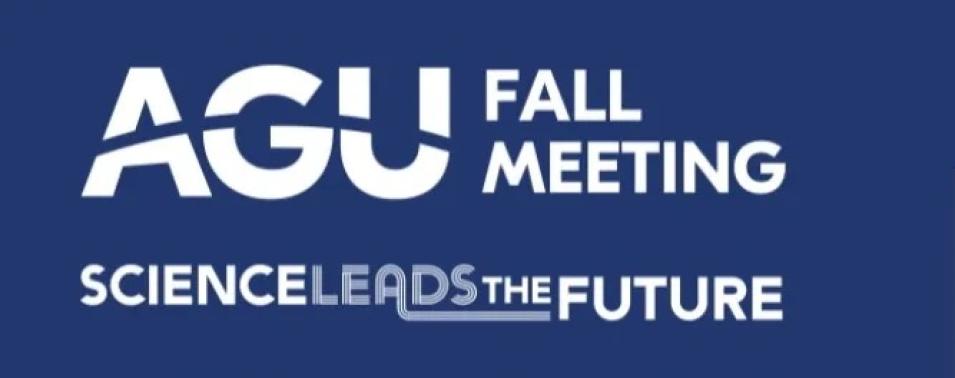The American Geophysical Union’s Fall Meeting 2022 is quickly approaching, with researchers from IMPACT preparing to present online or in-person or to participate in poster sessions. Below are previews of the five online presentations, which will take place Monday through Thursday of the conference in December.
Sneak Peek of IMPACT’s AGU 2022 Online Presentations

Monday, December 12
CARA: Context-based Acronym Recognition Approach will be presented by Ashish Acharya on behalf of Dai-Hai Ton That. This presentation will discuss context-based acronym recognition approach (CARA), used to recognize acronyms based on context, as well as its applications in remote sensing. CARA relies on the background knowledge extracted from real domain-specified data sources and a set of pre-defined heuristic rules for the recognition algorithm. CARA is also used for providing the full definitions for acronyms depending on context.
Tuesday, December 13
Iksha Gurung will be presenting Identification of Oceanic Mesoscale Cold Pools Using a Convolutional Neural Network Trained on Ocean Vector Winds on behalf of Stephen McNeal. Data collected over oceans can be used to determine the direction of the waves, and in turn, the direction of the wind. Thresholding on the horizontal gradient of these winds, the Ocean Vector Wind Science Team (OVWST) at Marshall Space Flight Center and the University of Illinois produced the first global climatology of cold pools over the ocean. In cooperation with the OVWST, NASA IMPACT trained a convolutional neural network (CNN) model on this global Cold Pool database with the goal of improving cold pool identification. This presentation will discuss the details of preprocessing techniques used and results from the CNN model.
Wednesday, December 14
Influence Network: Network Visualization of Influence Between Stories for Earth Science Data and Information Exploration will be presented by Dan Pham. Using storytelling to present data is an effective way to help data users gain deeper insight of information. The “data in action” story concept has been adopted by the NASA Commercial SmallSat Data Acquisition (CSDA) program to encourage creating and sharing data in story form. To aid researchers in exploring similar stories and data in their fields of interest, the team created an “influence network” within the “data in action” framework. The visualization provides insights into the influence flows between different stories within the system. The visualization of this “influence network” focuses on one story at a time, introducing a time series of neighbor stories that have the most influence on the current story. By focusing on views over time and visualizing influence flows between stories, the team aims to assist authors in understanding how readers perceive their stories as well as advancing their methods for delivering more meaningful stories to expand the use of CSDA datasets.
Thursday, December 15
Ashish Acharya will present Serverless Vocabulary Extraction and Curation for Cross-Divisional Search in NASA’s Science Mission Directorate. NASA’s Science Discovery Engine (SDE) is a cross-divisional platform enabling the discovery and exploration of data, software and documentation across the five Science Mission Directorate (SMD) divisions: Astrophysics, Biological and Physical Sciences, Earth Science, Heliophysics and Planetary Science. Built on Sinequa, a leading cognitive search framework, SDE allows filtering and faceting of data products and documents by relevant metadata such as instrument used, science keyword, or collection date. These facets are derived from categorized vocabulary lists compiled from 900+ sources across the five divisions.
This presentation demonstrates a cloud-based pipeline that crawls these sources to identify and store these vocabulary terms, allowing for the standardization of dozens of disparate formats and automated error-checking and consolidation. Finally, a web interface allows curators to analyze and curate the terms, which become search facets and power advanced features such as search term expansion.
Observing Supraglacial Lakes Using Semantic Segmentation and PlanetScope Imagery will be presented by Lilianne Thomas. Supraglacial lakes (SGLs) affect ice sheet dynamics through a positive feedback loop in which the albedo-lowering effect of SGLs can escalate surface melt leading to increases in lake extent and depth, which amplify the albedo-lowering effect. Implications of accelerated glacial melt include increased sea level rise and modifications to ocean primary productivity. SGLs are critical indicators of surface melt and its associated downstream impacts and should be efficiently monitored. Earth remote sensing observation data and machine learning enable scalable monitoring of SGLs through pattern detection and quantification of lake evolution over time.
This presentation will discuss an approach developed using supervised semantic segmentation leveraging a convolutional neural network architecture to train a model with labels from NASA Operation IceBridge and predict SGL occurrences in high temporal resolution PlanetScope imagery. The methods developed for processing the data, training the model, evaluating the model (both on a test partition of the IceBridge imagery and on custom annotated PlanetScope imagery), and implementing the model will be discussed.